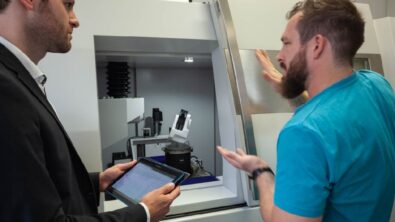Overcome challenges in manufacturing through convergence of OT and IT to enable a digital twin

The industrial manufacturing industry has many daunting challenges: global competition, low-cost providers, and customization. Also, other issues like the supply chain and the labor shortage broadly impact the industry.

Rahul Garg, VP of the Industrial Machinery Mid-Market Program at Siemens Digital Industries Software, discusses the blurring lines of IT and OT technologies driving smart manufacturing in a second episode of the Smart Manufacturing podcast series.
Rahul outlines how manufacturers are overcoming these challenges in the industry, including supply chain and labor shortages, using the convergence of IT and OT to create a digital twin to address pertinent issues, including using the Siemens Industrial Edge initiative.
Manufacturing operational efficiency
The convergence of information technology and operational technology is joining the boundaries of the machine manufacturing industry.
Improving operational efficiencies is essential to addressing current issues while finding alternative suppliers to determine how to get products and manufacturing set up correctly and efficiently with operators. Also, data is driving higher throughput and operating efficiencies. In most factory environments, it’s common to have a mix of older and newer equipment – newer smart machines that share data with a network and older machines that are in silos. Subsequently, a network of sensors provides all that data and brings it together cohesively.
Converging OT and IT
Information technology and operational technology are converging. Let’s define these terms. Operation technology (OT) is the factory’s capability – the operation’s software, physical equipment and the controls or technology driving the machines and PLCs. The software instructs the machine and ensures the hardware’s proficiencies. Information technology (IT) is the organization’s computer technology to store, retrieve, process, analyze, and act on the electronic information inside the operations.
Information technology allows management to make decisions, while operation technology drives actions in the factory. So, OT and IT collaborate to achieve significant operational efficiencies. Usually, there is a boundary between IT management in server rooms and office buildings and OT management on the factory floor, but that is changing. Now the information is flowing more seamlessly – which is essential.
In the factory, operational technology capabilities monitor the factory floor operations. So, capabilities like edge sensors stream data with an entire range of measurements, providing a sound knowledge of how the equipment is performing. Then this information is captured on the factory floor during operations and fed into the IP systems. As a result, these IP systems digitally optimize business decisions, analyzing data from the edge sensors on smart machines.
This setup creates a better view of equipment operations to make real-time decisions. In turn, these decisions assist in optimizing and maximizing throughput completed in the factories. It also provides knowledge of where machine parts might fail, run out of stock, or have issues that may hinder factory operations. Therefore, real-time knowledge allows for competent decision-making on rescheduling the shop floor, applying new support capabilities, or service technicians before the equipment fails. It creates an excellent environment to maximize and utilize factory operations effectively.
Convergence enables the digital twin
Furthermore, this data provides a valuable digital twin. The digital twin, a virtual digital replica of physical objects, machines, manufacturing systems, or the entire shop floor, provides a virtual duplication of each machine while the factory runs. And the IT and OT convergence offer real-time data and real-time information in this digital factory. Then the operational data ensures higher fidelity of the virtual digital twin, equating to higher visibility of real-world operations. Therefore, it is possible to see how the digital twin performs while the real twin is doing its work.
The IT and OT convergence and the digital twin provide access to actionable data. This data empowers improved decisions in an integrated manner to collaborate the planning, scheduling, and research regarding equipment performance. It also provides exceptional flexibility and visibility into operations, driving the ability to respond quickly to customer requirements and proactively understanding and responding to customers’ needs. The result improves efficiency to ensure zero downtime, zero waste, and zero operational issues – the triple zero. It also maximizes throughputs, lowering the cost to compete globally, improving overall sustainability, and minimizing resource usage, electricity, and water waste.
Siemens Industrial Edge
Additionally, the Siemens Industrial Edge initiative is an essential ingredient in convergence, containing the following elements:
- Edge sensors are available to a broad group of users.
- Open ecosystems allow integration, networking with manufacturers, and information from other manufacturing environments.
- Security and policy management using edge systems, open ecosystem and policy support.
Learn more in the audio podcast.
Software solutions
Xcelerator, the comprehensive and integrated portfolio of software and services from Siemens Digital Industries Software, helps companies of all sizes create and leverage a comprehensive digital twin that provides organizations with new insights, opportunities and levels of automation to drive innovation.
For more information on Siemens Digital Industries Software products and services, visit siemens.com/software or follow us on LinkedIn, Twitter, Facebook and Instagram. Siemens Digital Industries Software – where today meets tomorrow.


